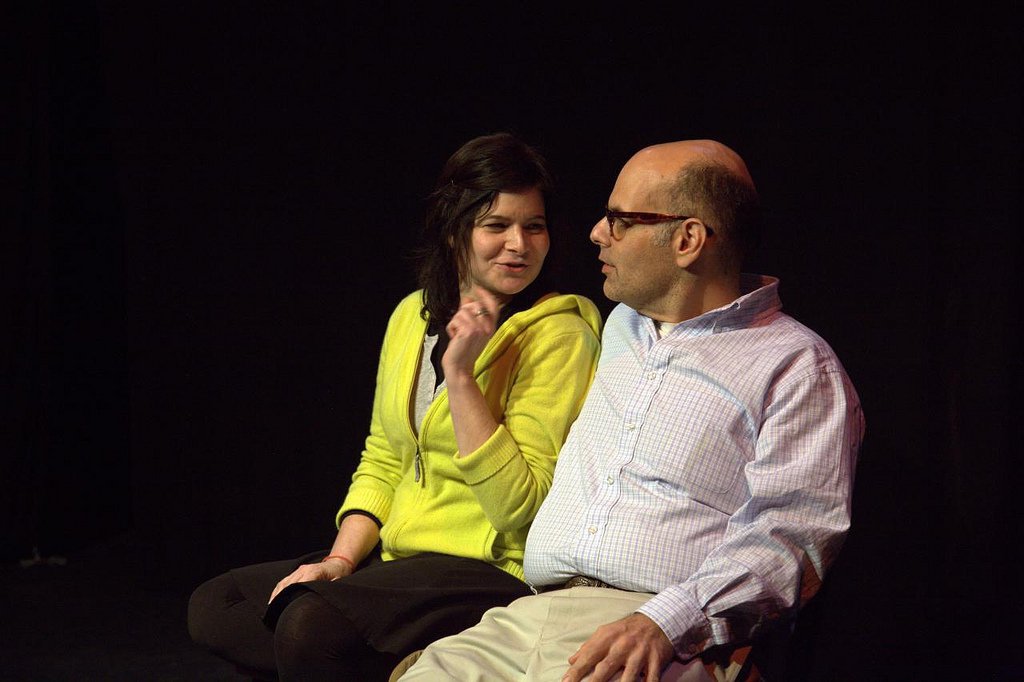So What Is Slow Improv, Exactly?

For the last 30 years, one of my passions has been slow improv. I have taught thousands of improvisers from everywhere from Omaha to Poland how to do it.
I’ve used the term in my marketing for years, but lately I’ve realized that not everyone knows what I mean when I say it.
So, if you’re wondering what is slow improv, exactly? Let me explain.
Slow improv is a style of improv that you would do in a long form show. It is sometimes called “slowprov” or “slow play” because the pace is slower and more patient than what you’d find in regular long form improv. The scenes typically are more grounded and relationship-based. They tend to be more “slice of life” scenes than wacky or fantastical scenes. For example, slow improv scenes may be about:
- Two jealous high school girls getting ready for the prom
- A powerful businesswoman who is checking into a hotel and recognizes that clerk used to be her first boyfriend from high school
- A couple who is on their first date and neither one of them looks like their photo from their online dating profile.
In slow improv, the humor comes from the audience’s relating to the behavior of the characters in the situation.
I first learned how to play slow improv from Del Close at the Improv Olympic (iO Chicago) back in the ’80s when he was teaching us The Harold. I fell in love with that style of improv because I saw how it helped make my improv more honest. I especially liked how organic it felt, as compared to the faster, funnier improv. Over the years, I’ve seen improv speed up, but I believe today more than ever there is room for slow improv.
One thing that differentiates slow improv from other types of improv is that it typically is emotionally based, something I was not even aware of until recently.
I was interviewing Sam Wason, the author of Improv Nation, on my podcast, Improv Nerd, and we got to talking about slow improv, and he said, “If you go slow, you can’t miss the emotional moment, and then you really can’t lose.”
Because the pace of slow improv is slower, it gives you the opportunity to feel and react to the emotional moments in the scene. In my classes and workshops, when it’s done well, it looks like a one-act play or a scene from a movie.
But slow improv doesn’t mean we have to be going slow all the time. You may do a scene where the energy is chaotic, and you are all shouting at each other with excitement. As long as you are connected and reacting to each other, that’s all that matters.
I first began doing slow improv more than 40 years ago, and since then, I have devoted my life to teaching this form of improv and have seen how it helps students become better actors. They learn how to emotionally react to their scene partner and commit to the imaginary circumstance. And when they do this, guess what happens? They are more committed to the situation, more truthful and funnier.
Doing slow improv also forces the improviser on a subconscious level to tap into their life experience. Once they start working this way, their comedic voice will start to emerge automatically.
They will be more interesting to watch because they won’t just be talking, they will be feeling. They will be more confident and make bolder choices. The dialogue will sound natural because they are free from the burden of being clever and witty.
But what makes slow improv truly special is the bond the players have to each other when they work together this way, something I hope everyone gets to experience.
Regardless if you drink the slow improv Kool-Aid or not, if you are a short form or long form player, I think trying slow improv can help any improviser with their scene work. I hope one day, you get a chance to try it, too.

